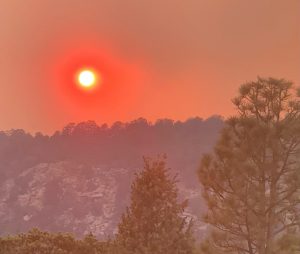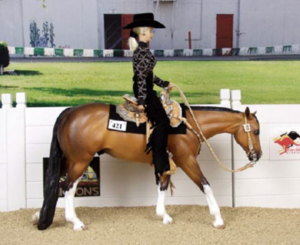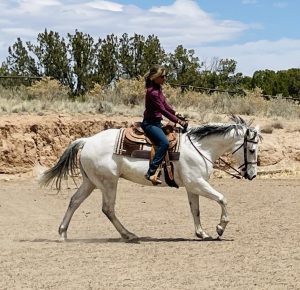Editor’s Note: Best Horse Practices Summit presenter Katrin Silva grew up riding dressage in Germany before moving to the United States at age 19 to learn to ride Western. She’s been riding both disciplines for the last 20 years and is a regular guest columnist for Cayuse Communications. The author of Dressage for All of Us: How to Help Any Horse Become a Happier, More Responsive Riding Partner lives in New Mexico where she works with dressage and Western clients.
Katrin’s upcoming book is Riding with Feel: A Guide for the Rest of Us, due in Summer 2022. Read more about that here.
 Katrin writes:
Katrin writes:
Forest fires are burning all around New Mexico right now. My horses and I are not in danger, at least not yet, but I know many people who have had to evacuate with all their animals. School gyms and county fairgrounds have become emergency shelters. The flames have consumed more than 200,000 acres, with no end in sight. Some say it will be July before the fires are contained. Homes and ranches and entire villages, have burned to the ground, leaving families with nothing but what they could grab, their way of life destroyed by the flames.
From where I work and ride, I can see and smell the smoke. Our blue sky has become hazy, coloring the world in muted hues. Tonight, the sun sets as a fuzzy pink ball over the mountains, like a maraschino cherry past its sell-by date, floating in a cocktail made from dubious ingredients.
 If I didn’t know what caused these changes in our evening sky, I’d find them beautiful. I would marvel at the unusual shades of red and orange, the eerie light, the absence of sharp edges. But I can’t un-know what I know about all the destruction and suffering the fires are causing to communities in Northern New Mexico. I can’t separate the people who have lost everything from the pastel sunset. I can’t find pretty anymore.
If I didn’t know what caused these changes in our evening sky, I’d find them beautiful. I would marvel at the unusual shades of red and orange, the eerie light, the absence of sharp edges. But I can’t un-know what I know about all the destruction and suffering the fires are causing to communities in Northern New Mexico. I can’t separate the people who have lost everything from the pastel sunset. I can’t find pretty anymore.
There’s an interesting parallel to horse shows in these images. Someone who knows what a happy, balanced horse looks like cannot find beauty in an unhappy or tense horse. It matters not how spectacular his movements are or how many blue ribbons he’s won. Someone who knows natural, correct biomechanics cannot admire gaits that have lost their rhythm or cadence, no matter how flashy they are.
In many competitive disciplines, a horse’s natural, functional way of going is taken to questionable extremes. Trainers present more and more exaggerated versions of gaits or movements, in the mistaken belief that, if a little bit of something like is good, more must always be better.

An uncomfortable Western Pleasure horse
Western pleasure is a good example. What once was a way to showcase a relaxed horse that’s a joy to ride has become a parody of its original purpose: a contest of how slow a horse can go with as low a headset as possible. The walk is a crawl, the jog a toe-dragging shuffle, the lope a crab-like parade down the rail, with the horses’ haunches stuck way over to the inside of the arena. None of this looks enjoyable for anyone involved, horses or riders. It’s painful to watch. Finding it beautiful takes cultural, habitual conditioning or a huge dose of . Women used to wear restrictive clothing, like fishbone corsets, hoop skirts, or stiletto heels. Attractive? Most of us find these fashions abhorrent today.
Competitive dressage may be heading in a similar direction. At its core, dressage develops any horse’s – natural way of moving through a progression of gymnastic exercises designed to help him carry a rider more comfortably. In the competition arena, we see something different: it’s a contest of how much crossover the horse’s legs can show in lateral movements, or how much overstep is possible in the extended trot.

Another un-pretty Western Pleasure horse
Reining competitions have become a quest for longer sliding stops and faster spins.
Gaited horse shows seem to measure how high a horse can throw his knees, etc.
The tradition of clipping a horse’s facial hair – a practice that is thankfully fading – is another example of misguided beauty standards. Many years ago, I used to clip all horses in my barn because the trainers I apprenticed with did it that way. In the world of horse shows, a well-groomed horse was a smooth-faced horse. I was used to looking at clipped horses, like the Victorians were used to looking at women in fishbone corsets. I believed it was somehow acceptable. But a horse’s whiskers have real purpose in sensory perception. They are called vibrissae and each one has an important sensory nerve. Clipping horses deprives them of essential feeling and awareness. Once I learned this, I stopped. I could not find a clipped horse beautiful anymore.

An engaged, relaxed Western horse
I still believe it is possible to compete a horse responsibly in almost any discipline. But we have to be aware of the temptation to sacrifice our horse’s welfare and happiness for a blue ribbon. We must draw lines we don’t want to cross. If the purpose of any competition does not promote a horse’s long-term athleticism, soundness, and mental health, the beauty we want to create becomes an exaggerated, unhealthy version of the ideal we are trying to achieve.
You nailed it, Katrin. I can hardly watch any competitions anymore. Observing what some people are willing to do to their animals for a piece of blue fabric is appalling.
In every competition, there’s appalling stuff happening – and then, there’s good horsemanship, too. I am not ready to give up on horse shows altogether, but we have to put the horses first.
Well said, and nicely balanced. Your photos of western pleasure vs relaxed western horse are good illustrations. We need more articles like this, with corresponding photos to help people see the difference.
Thank you, Lynn!
That top pic is of a Barbie Doll and a plastic horse!! It’s almost too close-to-the marrow for comparisons w today’s Western Pleasure standards of “beauty.” I am forever soured on the world of showing, bc of the very comments you mention!!!
Thank you for your courage in speaking out!!
Western Pleasure has become so artificial – the black hoovves, the fake tails, the sparkly clothes, and the horse’s way of moving to match all the other fake stuff. I show western dressage these days, because there’s more emphasis on harmony and good horsemanship.
Yes, indeed. Art will not be commodified! Horsepersonship is an art! Only in the Master-Slave relationship is equestrianism commodified. I remember a time when you had to earn a trophy buckle, and school your own horse. Now you just pop down to your local feed store and purchase one. Or buy a horse somebody else trained. Sad. And the horses pay the price for our arrogance, and stupidity. Yes, something irreplaceable is in danger of being lost forever. A horse is not a piece of sports equipment! Horses can teach us self-control, and empathy, qualities that are important in all of our lives. But there’s no money or gold in responsibility, or in understanding the mentality of the horse.
Hi Sara, it’s true that riding is an art – but like in writing or painting, there’s lots of room for different art styles. As long as we respect horses and put their welfare first, competition is not a bad thing. I, too, remember a time when local all-breed shows were a friendly, welcoming place to meet other horsey people and to expose horses to new things. How we placed was not all that important, compared to practicing good horsemanship and good sportsmanship. We need to re-claim these values.
Dear Katrin. My eyes teared up as I read your magnificently constructed message. When I clicked on your article because of the title, I held hope you’d be addressing this subject with some courage. You far exceeded my expectations and I’m hugging you from deep in the heart.
For more than 20 years, my passion has remained focused on finding ways to help ridden horses get the chance to travel more comfortably under saddle equipment. Among my dreams: a judge won’t allow a competitor into the arena if she/he can’t slide a hand under the front of the saddle pad up along the tree almost all the way back to the stirrup bar. I’ve pretty much stayed in my lane in publishing things…but the concept of “changing the standard of beauty” in the arena for so many sports (you’ve identified several) is one I’ve spoken of privately to many. The competitive goals so often put in front of humane principles result in heartbreaking waste of beautiful horses. I’m eager to do more to help you enlighten those who can help change it. Thank you so much.
Dear Letitia, thank you! There’s good horsemanship out there, in competitive settings, but there’s also the waste of good horses you mention. It’s a complex issue: judges can only judge what they see, competitors feel they need to present a certain picture, trainers feel pressure to rush young horses and to mold them into what they think judges want to see, owners feel they have a right to get their money’s worth from a trainer, breeders feel pressured to produce a horse they can sell at a younger age for a higher price. But most trainers, breeders, owners, judges, and other horse people I know participate in the show industry because they love horses. Or, at least, they got into the horse business because they once loved horses, and then became disillusioned somewhere along the way. It’s not an easy way to make a living. I think we need honest, mutually respectful dialogue about what is going on if we do want to change it.
The more I read the stuff you write, the more I love you! I’m a huge fan ever since I met you at the summit last year. Thank you for addressing this topic as it is one of the reasons I can’t watch some horse shows. I have a young lady who entered a jumping competition and killed the course but was disqualified because she did it in a bitless bridle. I would think she would have scored extra points instead for having such a successful run with a horse that was soft and willing to do it in something close to a halter. The worst is when I look at a cover of a magazine and “beauty” is defined by a foaming mouth with a head that breaks at the neck instead of the poll. I find myself wondering what happened to our values and priorities.
Thank you, April! I agree – we need to have more honest conversations about values and priorities, and about what good horsemanship really means. I didn’t know bitless bridles were not legal for jumping. I’ve seen some of the bits and contraptions that are legal. It makes no sense.
Beautiful expression of reality…back up by beautiful visual likenesses …
Thanks, Katrin! Looking forward to you new work too!
Bravo!
Thank you, Mary Ellen. I look forward to hearing what you think about my new book!
I love the thread re bitless bridles. If your horse is well-enough trained to go bitless, you should be able to compete that way!! The tie-downs, the long-shanked bits, the twisted-wire mouthpieces, all make me cringe!!!
The torments done for the flimsy, superficial ribbon really tell the tale!!!
My boys go in a rope halter, but they have been schooled to flex, both vertically and laterally, for safe riding.
Thank you all, wise women. Maybe we will see change in our lifetimes!!
Something I read about this once stuck with me (but not the who or where — one of my resources): most of the “odd” horse positions in Western Pleasure stem back to judging. Some judge gave high marks to horses and riders who did this different thing, and everyone wanting those high marks started doing that and so forth and so on. Your column reflects the same thing. Competition drives the desire to be different, more, unique, etc. The bottom line, though, is that we get what we reward. I’d imagine those that positively judge these exaggerations want to fit in and also reward what their peers reward. It’s human nature. Too bad that all seems to ignore horse nature. Your reply where you describe the spiral of complexity is right on!